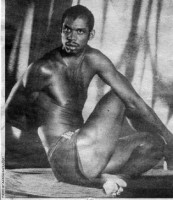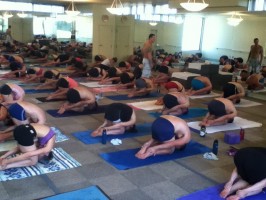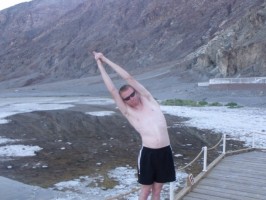For those looking for a healthy and challenging way to effectively use one and a half hours of down time, The Very Blog recommends trying hot yoga (Bikram yoga in particular). Extremely difficult yet beneficial, this exercise is a good way to make the most of one's day.
You know the drill, the hubby has invited the boys round and declared the evening be filled with nothing but pizza, beer and general heckling at the TV. Now if you’re anything like me, this is not an appealing proposition. While I can be tempted to sit down and watch a game or two of the Wimbledon final, football just doesn’t do it for me. As such I have quite the repertoire of what-to-do-when-the-usually-attentive-other-half-is-staring-at-22-men. Top of the list is generally whine at him, point out what a waste of his time this is and sulk until the final whistle. However, when I’m feeling a bit more proactive the first thing I do is head down to my Yoga studio for a sweaty session.
If you’ve yet to try Hot or Bikram yoga then the next time there’s a match make sure you book yourself into your nearest class – then spend the day gulping water and prepare to revolutionise your workout world.
The Low Down
Bikram Yoga: Bikram classes are always 90 minutes long and always do the same 26 postures, twice each with a starting and finishing breathing exercise. It may sound repetitive, but believe me that will be the last thing on your mind. More common thoughts are …
“Wow I didn’t know my eyes could sweat”
“Oh my goodness my face is just one big sweat gland”
“What on earth is a Camel pose?”
You see, Bikram Yoga is the pinnacle of Hot Yoga as it is so strict (no leaving the room, no talking, only very little water at set times) and so regimented. It transforms you body as the postures stretch, strengthen and lengthen muscles you didn’t even know existed and the heat and humidity (40 degrees, 40% humidity) force every last drop of sweat out of your body. It is incredibly challenging, the aim of your first class is just to “stay in the room” and believe me, that is enough of an ask!
Hot Yoga: Hot yoga is a loose term for any physical yoga practice performed in a hot room. This means you can do a standing series, a flow class or even something like a Jivamukti class in the hot room. The benefit of a hot yoga studio is the sheer variety of classes you can try out, and I think this is a better choice for a beginner. Plus, they tend to be a bit less strict so if you need to leave the room to cool down/cry then you can! Common hot yoga thoughts are …
“What is that smell? Coconut? No, Jasmine?”
“Is Vinyasa a type of curry? Why is she talking about food?
“I’m just going to crawl into childs pose and pretend this isn’t happening”
It’s an incredible intense workout - you will notice as the weeks go by that your posture improves, you sleep better, your skin clears up and your breathing is more disciplined. That’s the beauty of yoga, it works your body the way your body is meant to be worked. Every single runner will admit to the pain, discomfort and injury that comes hand in hand with running, but yoga is the opposite – it’s like therapy for your body! Not to mention, it slims, trims and tones you ready for bikini season.
Yoga is often described as a moving meditation, so whether it’s Bikram or Hot, why not try a class and arrive back at home in a state of blissful calm, it might help you focus as you hear every-single-detail of the match.
Brandie Frommelt is a certified Bikram yoga instructor and the the studio director of Bikram Yoga Westside. Visit this Google+ page for more on her and her career.
















